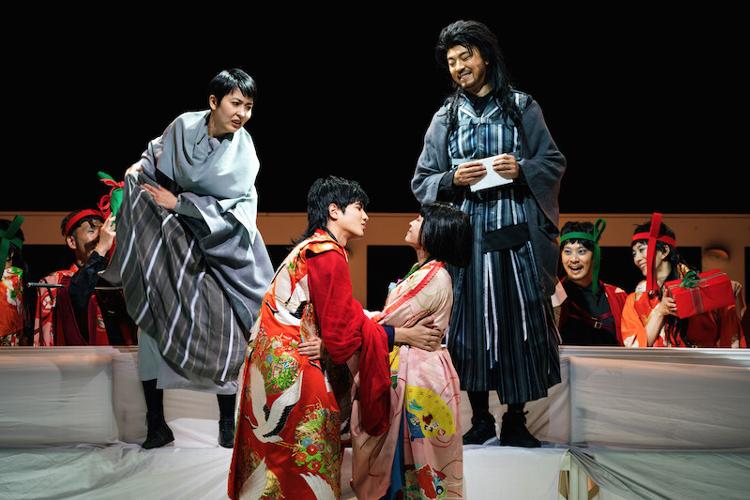Romeo and Juliet like you’ve never before seen or imagined. In late 12th Century, Japan two sets of Romeos and Juliets (past and future versions of the characters) encounter one another. Amidst a troubling clash between their respective Minamoto and Taira clans, the age of the Samurai is ushered in. As their future selves return in time hoping to rewrite their storied past, we reencounter R + J with a renewed sense of possibility and hope. Legendary theatre maker Hideki Noda OBE returns to London with an operatic, frenetic, and imaginative rendering of Shakespeare’s classic story of love underscored by the music of Queen.
As playwright, director, and performer, Noda doesn’t miss a single beat. This is a once-in-a-generation kind of an artist whose innovative, colorful, comedic, and expansive work is on perfect display with this production. The operatic play moves largely at rapid speed with gorgeous choreography and movement by Shigehiro Ide throughout. This is a rare evening in the theatre free from “transitions.” Instead, there is only ever a slight lighting shift or sound cue to usher in a new scene or context, sometimes called off the mere flick of an actor’s wrist. With this production’s impressive pace, it is all the more astonishing to bear witness to the unity and precision that the company of over twenty performers have managed to find.
The play begins suddenly, snapping into action as a company of actors enter the empty space on hospital beds which shape-shift throughout the piece becoming chariots, battle shelters, boats and more. Yukio Horio’s set design is superb and features a malleable set featuring revolving doors forming a thrust around the stage along with an elevated platform which offers quick entrances and exits as well as space for duel scenes. Horio pulls out every stop to great effect offering the play mobility, momentum, and deep beauty. The lighting design by Motoi Hattori shifts suddenly and effectively as we journey through time and space. Kodue Hibino’s costume design is colorful, evocative, and manipulable allowing for versatility and movement.
This company of actors are astonishingly active in their physicality which isn’t unexpected as this is an evening of Kabuki Theatre. But as articulate as they are with their bodies, these actors also balance the macro of the external expression with the micro of the emotional. To talk about any one individual is impossible to do because all are so well cast but I would be remiss not to mention the four who take on Romeo and Juliet as they each posses a presence, vulnerability, and depth beyond their years. Takako Matsu, Takaya Kamikawa, Suzu Hirose, and Jun Shison are each stars in their own right and we invest heavily in the story thanks to their gifts.
This production is one of those rare, spectacular experiences in the theatre that audiences will look back on for years to come and say: I was there.
It runs until 24 September.
Review Matthew Pierce Photo: Alex Brenner

